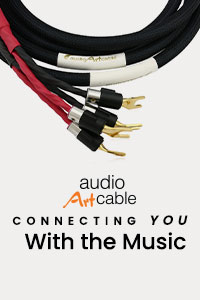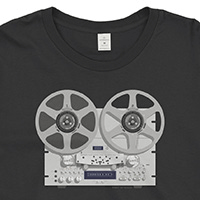The Luxman K-05 Cassette Deck
-By Paul DeMara
The 1990s were an interesting time for music formats. CD’s were hot, vinyl was dead, and cassette tapes were the primary way people listened to their tunes while driving.
Fast forward to 2020, and cassettes are cool again. When I visit many of the local music stores in my area, cassettes are proudly displayed next to vinyl and CDs. Type the words “Cassette Decks Vintage” on Facebook, and there are thousands of enthusiasts sharing their stories and photos.
For the passionate audiophile, cassettes may seem like a sub-standard analog format versus reel to reel or vinyl. However, cassettes offer something that vinyl doesn’t – the ability to create analog mix tapes of your favorite tunes. It’s easy to spend a good 3 or 4 hours making a 90-minute mix tape while fussing over the song selection and recording levels. What do you get for this investment in time? Making a mix tape brings me closer to the music in a way that a Spotify playlist does not.
Compromises
A good friend of mine who designs audio gear is quick to remind me, “Everything is a compromise.” He was absolutely right. Cassettes are a compromise from reel to reel, but going down the R2R path to make analog mix tapes requires a significantly more substantial investment in hardware and software. Perfection in audio doesn’t exist, but a premium deck with premium tape, crafted with care, offers a positive, emotional listening experience. (Interestingly, while writing this article I happen to be listening to a 1997 pre-recorded cassette, Diana Krall – Love Scenes)
Audiophiles, by nature, are often looking for “the best of the best.” The Nakamichi Dragon is a grail to many, and it’s certainly a fantastic deck, but there are other options. I submit the Luxman K-05 is one such option. You don’t get auto-reverse, automatic azimuth adjustment, and several other features with the K-05. What you do get is superbly engineered Luxman electronics, including their proprietary “duo-beta” feedback bass extension technology. Their cast metal tape transport with dual capstans and dual bearings, crystal-controlled user variable transport motor speed control, accurate analog VU meters, automatic electronic tape bias equalizer with manual adjustment, and most importantly, micro aligned tape heads all add up to an industry-leading upper frequency response. Some say the equal or superior to the mighty Dragon.??My K-05
Tape heads naturally magnetize during playback inhibiting treble response, requiring regular tape head demagnetizing using a unique tool. The Luxman engineers took care of this issue, and it is built-in on the K-05, something I didn’t notice until after I purchased mine. Every time you power up the K-05, there’s a few second delay while an A/C signal is sent to the heads to demagnetize them. All you need to do is clean the heads every 10 hours or so.
Specs don’t reveal the “tone” of a piece of audio gear, but they can offer insight into how much effort went into the engineering of a product. Luxman, as they do with all their products, chose to focus on “technical excellence” with the K-05. The better specs that are a result of tighter quality control and construction tend to cost the manufacturer more money to build. And again, everything in engineering is a compromise. For reference, the K-05 has an extended frequency response of 15 Hz to 27,000 Hz (metal tape), with a wow and flutter of 0.022% along with signal to noise ratio of 60 dB with the Dolby noise reduction switched off. The THD is 0.5%. Getting to those specs cost time and money for Luxman. ??Sonics and use
I’m a low to medium volume listener, and at low to medium levels (for me, 90db and under), I’m hard-pressed to hear a difference between source material and something recorded with a good chrome or metal tape. This is easily confirmed using headphones with the source/tape button while using an audiophile-grade source like MoFi vinyl on my turntable. It’s important to note that you can tweak the auto-bias settings with the manual bias control to achieve your version of perfection. Keep in mind less bias (left of center) offers enhanced treble but weaker bass, more bias (right of center) improves bass but decreases treble.
The biggest “gotcha” with cassettes is they tend to have noticeable hiss at higher volume levels. (Hiss effectively defines the noise floor) To minimize hiss, Dolby B and C are available on the K-05. I’m not a big fan of Dolby noise reduction, but the Luxman engineers did it right with the K-05; when you engage Dolby B or C, there is no treble roll-off. This is a common problem with other decks, particularly with Dolby pre-recorded tapes, because not all decks are calibrated accurately. As a result, I tend to listen to pre-recorded cassettes with the Dolby B turned off. The sonic signature and pace of my favorite tracks still comes through to keep my foot tapping.
The K-05 captures more than enough musical nuance to provide serious emotional involvement, where the compromises made with other cassette decks often do not. My background in electronics sends me to the circuit design first. Luxman uses a sophisticated multi transistor tape head amp in this deck where many other manufacturers get by with a simple 2 or 3 transistor design. This circuit offers enhanced dynamic range as well as a lower noise floor along with low-frequency waveform phase integrity. This is the technical stuff that translates to great sound.
Thoughts on the user interface
As shown in the pictures, the Luxman K-05 is champagne gold with black letters, which for my old eyes, is far easier to read than white letters on a black background. The big, well-lit analog VU meters remind me of an earlier time. The tape transport and automatic bias controls are touch buttons. Slider controls are in place for left, and right recording levels as well as a master control for smooth fade in / fade-outs when making recordings, flanked by a row of metal knobs below the record level controls allows for various record/playback adjustments. The transport responds quickly and quietly to any request. Two buttons I regularly use are the “auto rewind” & “auto-repeat” buttons. If you don’t feel like getting up to turn over the tape, engaging these buttons cause the deck to reverse at the end of a tape and then play from the beginning.
The variable speed control is another rare feature. Not every cassette out there is aligned to the same speed, and this control allows you to fine-tune pitch. Again, these are the kind of engineering details you generally won’t find on other decks. Finally, the tape head has a special narrow width gap that holds the little pad on the cassette tape behind the tape away from the tape head. This removes some of the tape head scratching that can occur from pad pressure. The dual capstans rotate at slightly different speeds to create the required tension on the tape head, as it is on pro-grade reel to reel decks.
Just as specs don’t tell you much about tone, they don’t tell you anything about the mechanical feel of a component, you can only get this from hands-on experience. The K-05 weighs almost 25 pounds, and all of the controls have a solid, weighty, positive feel. Luxman even included two extra lamps in the box for each meter. As with today’s Luxman components, the K-05 feels like a luxury item that has been meticulously cared for during assembly.
One thing that’s hard to quantify is the “feel” of a piece of audio gear. The K-05 weighs in at 11.5 Kg or ~25 lbs. and pressing the controls or adjusting levels has a smooth solid feel. The Luxman engineers paid close attention to how the analog meters look and included 2 lamps for each meter. (I can imagine everyone now looking at their cassette decks to check how many lamps were included) The deck also sports metal knobs and a 3D look using different materials. “Solid” is probably the most straightforward description.
To conclude, the K-05 is one amazing piece of early 80’s engineering, produced from 1983 to 1985. 35+ years later, this deck still gets kudos from cassette enthusiasts. It doesn’t have the notoriety of the Nakamichi Dragon, but that’s the point. This is a deck that cassette connoisseurs lust after and never sell. The challenge is finding one – clean ones are fetching upwards of $4,000 these days.





